I don’t hate my smartphone’s “AoooOOgah” alarm too much when there’s a good reason for it. This time, it’s an O-dark thirty wakeup call just a few miles from Bosque del Apache National Wildlife Refuge. Bosque is where many snow geese and sandhill cranes go to spend the winter. They begin arriving in late September or early October, and stay until late January.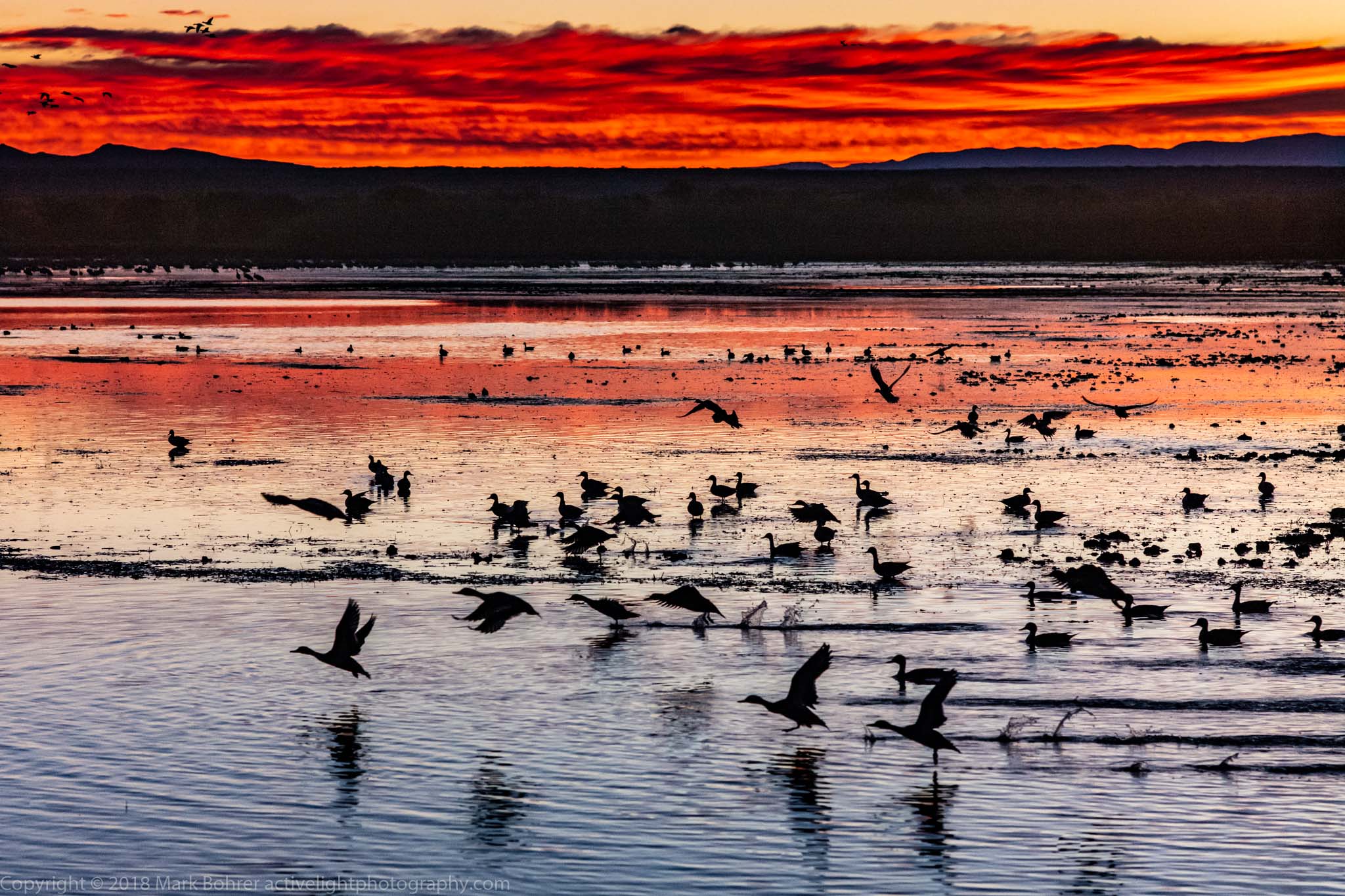 Snow Geese at Sunrise My quest was to capture geese, cranes and any ducks in sunrise colors with autumn-colored backgrounds, preferably in flight. I was OK with swimmers too, but I wanted great light. From past experience, the snow geese will thunder aloft as one, with loud gabbling calls and a wind-machine whir of wings. But when I was out there last December, sunrise color was non-existent. I hoped this time in late October would be different, and would give me some autumn leaf color too. I wasn’t disappointed. 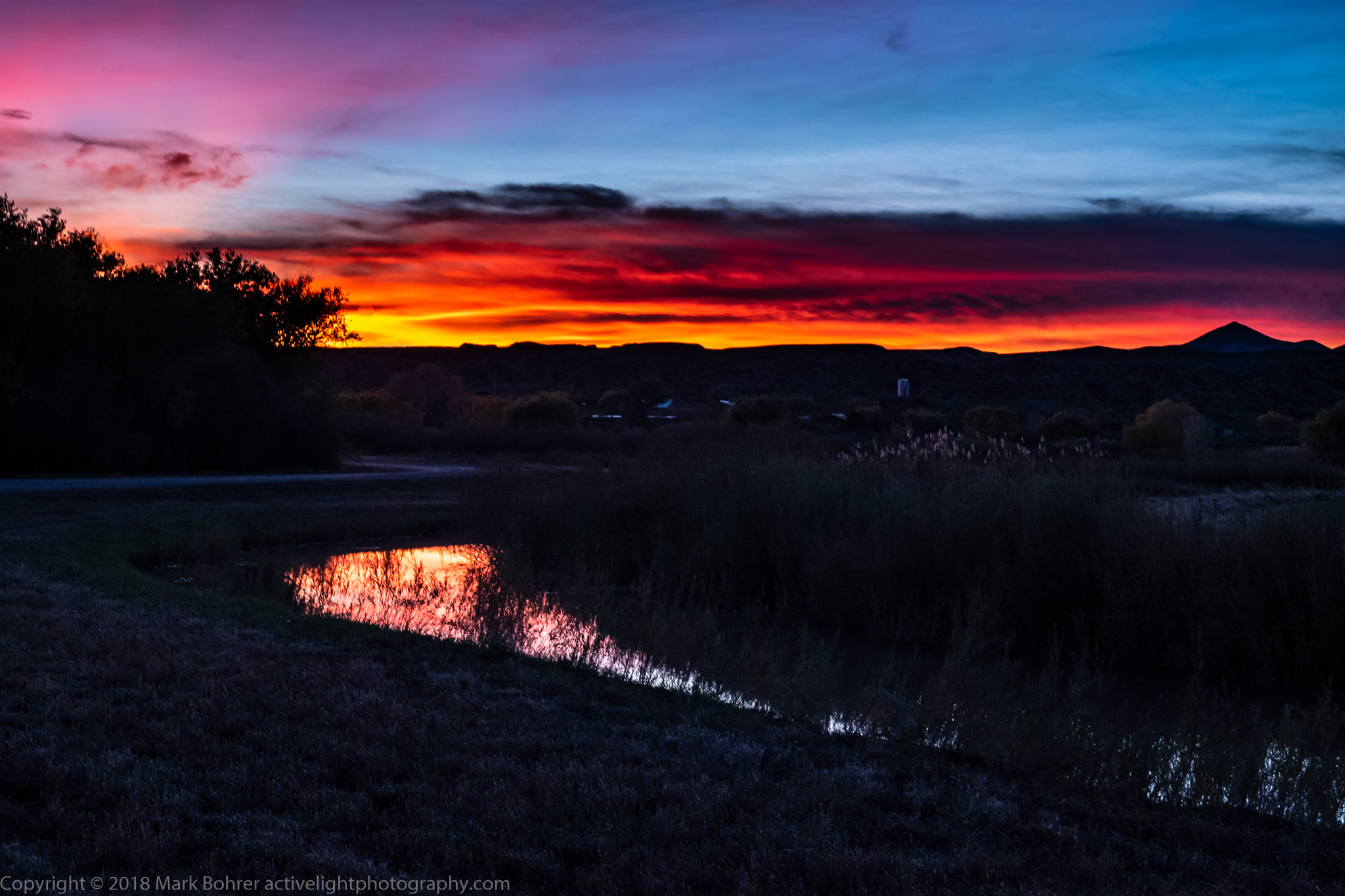 Curves into Sunset Capture the Evening… I’d already captured some evening color the previous day. After driving the biggest loop surrounding the refuge, we’d found most birds in the northern ponds. There were random airborne comings and goings as the sun set further and further. I found a curving creek reflection for deep red-orange light. A parallel curving road along the creek led another eye-route into the picture. Exposing mainly for the highlights gave me great red colors, at least on the camera’s LCD. With both Canon and Leica cameras, raw capture gives you recoverable shadow detail – as long as you don’t try to brighten shadows too much. I thought I’d gotten it, but you can’t always tell from a camera’s LCD or even from a histogram. Since I figured I had my landscape color, I felt I could relax a little the next morning. A Location Crap Shoot Geese have their own reasons for picking any given location. We were lucky enough to spot a large flock in the ponds nearest the entry to the refuge. I grabbed my rangefinder Leica M10 with 135mm f/4 short telephoto, mirrorless Leica SL with 24mm f/1.4 wideangle, and put the EOS 5D mk IV dSLR with 400mm f/4 telephoto over a shoulder. 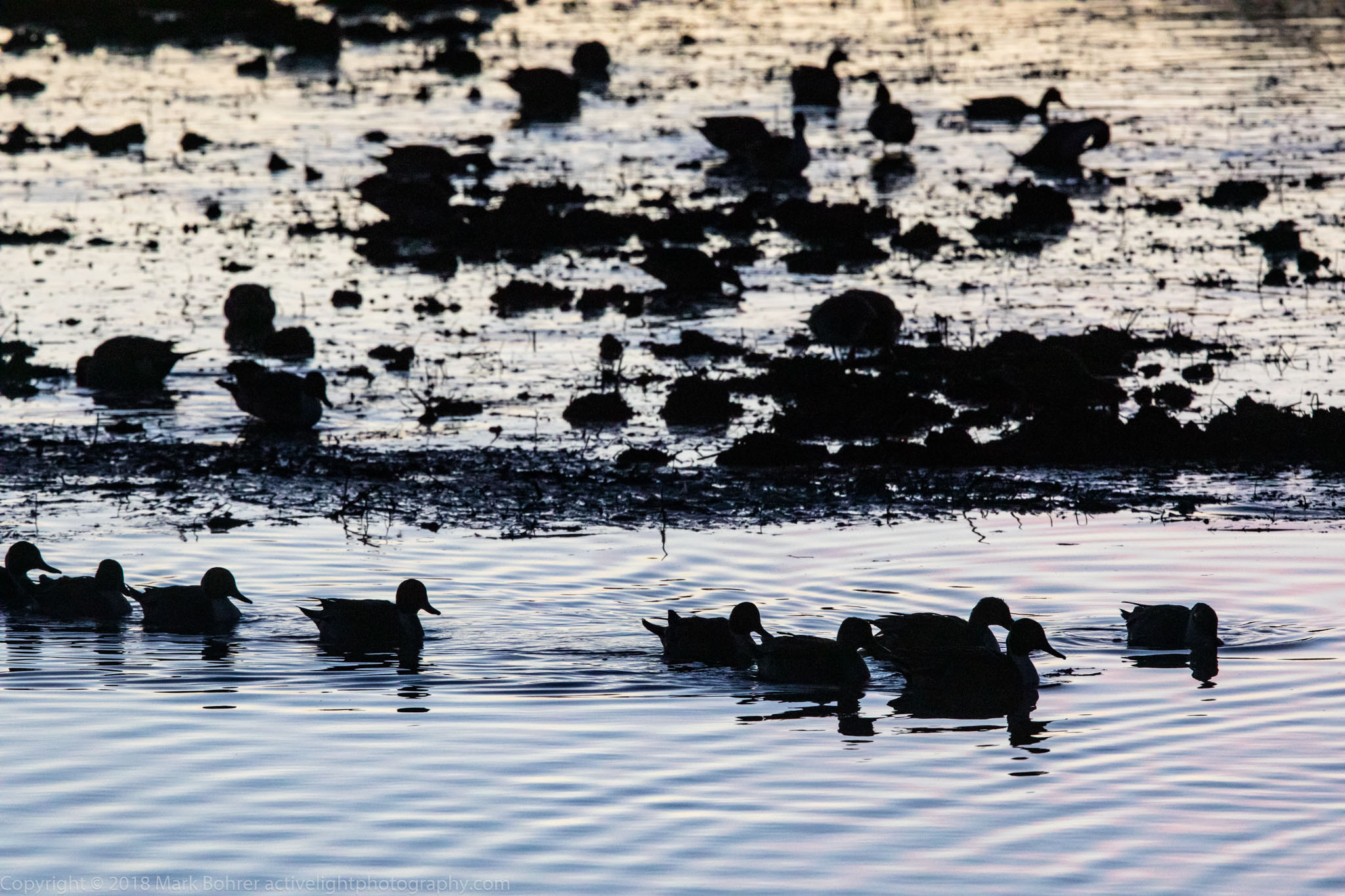 Northern Shoveler Silhouettes I could see the bright spot on the mountain horizon where the sun would make its first appearance. Closer in, broad-billed northern shovelers lived up to their name as they dug in the shallows for prey. And there was a big flock of snow geese preening and gossiping with their neighbors, almost out to the far side of the pond. After shooting some landscape pictures with near and far subjects, I set up the EF 500mm f/4L IS on 1.4X teleconverter. Since this was on a crop-sensor EOS 7D, it was like a 1120mm f/5.6 lens. I had the combination on a Wimberley Sidekick gimbal head and beefy Gitzo 1625 mk II tripod. Everything was steady and balanced – I could move it with a fingertip. 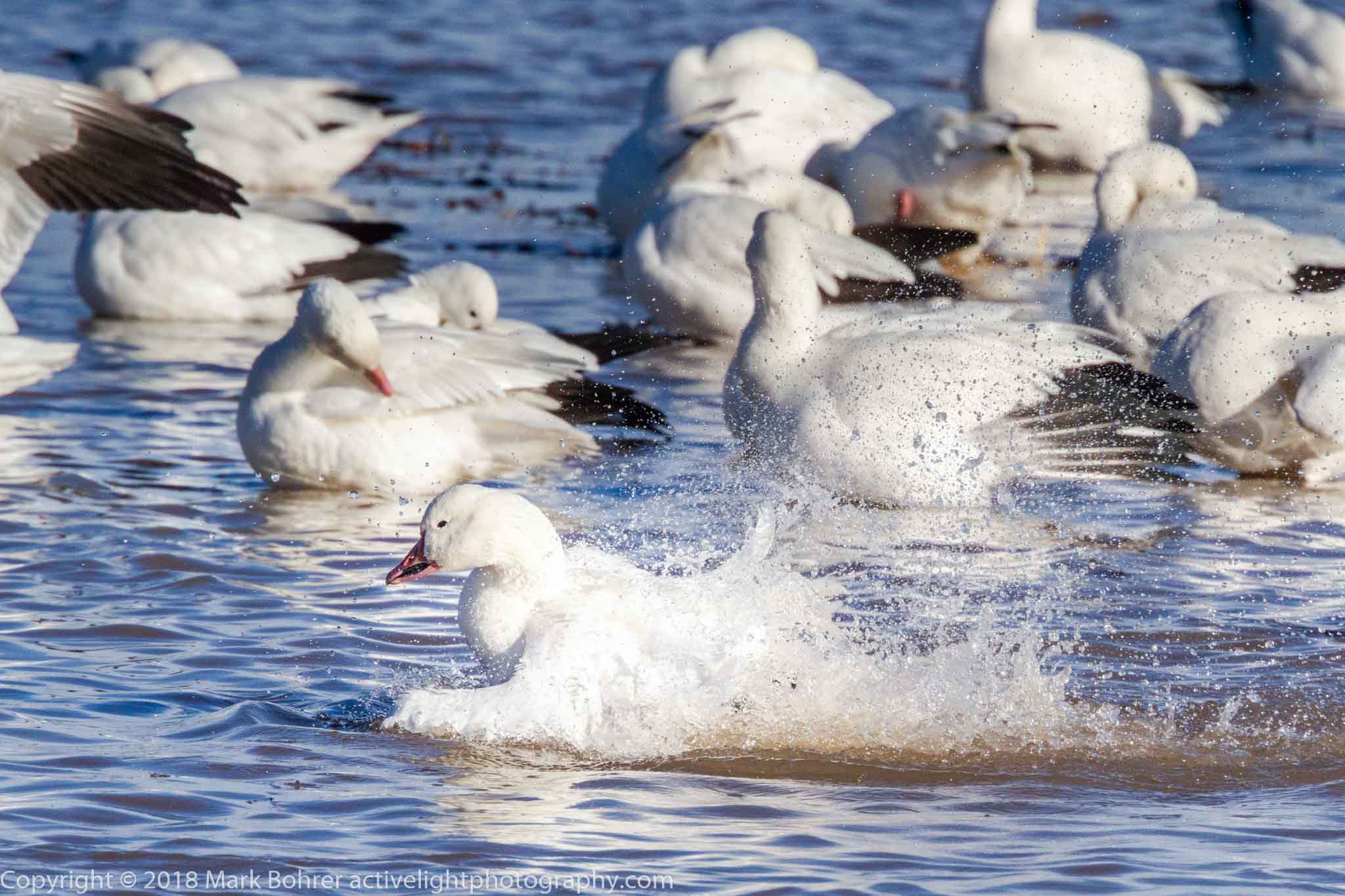 Young goose splashing 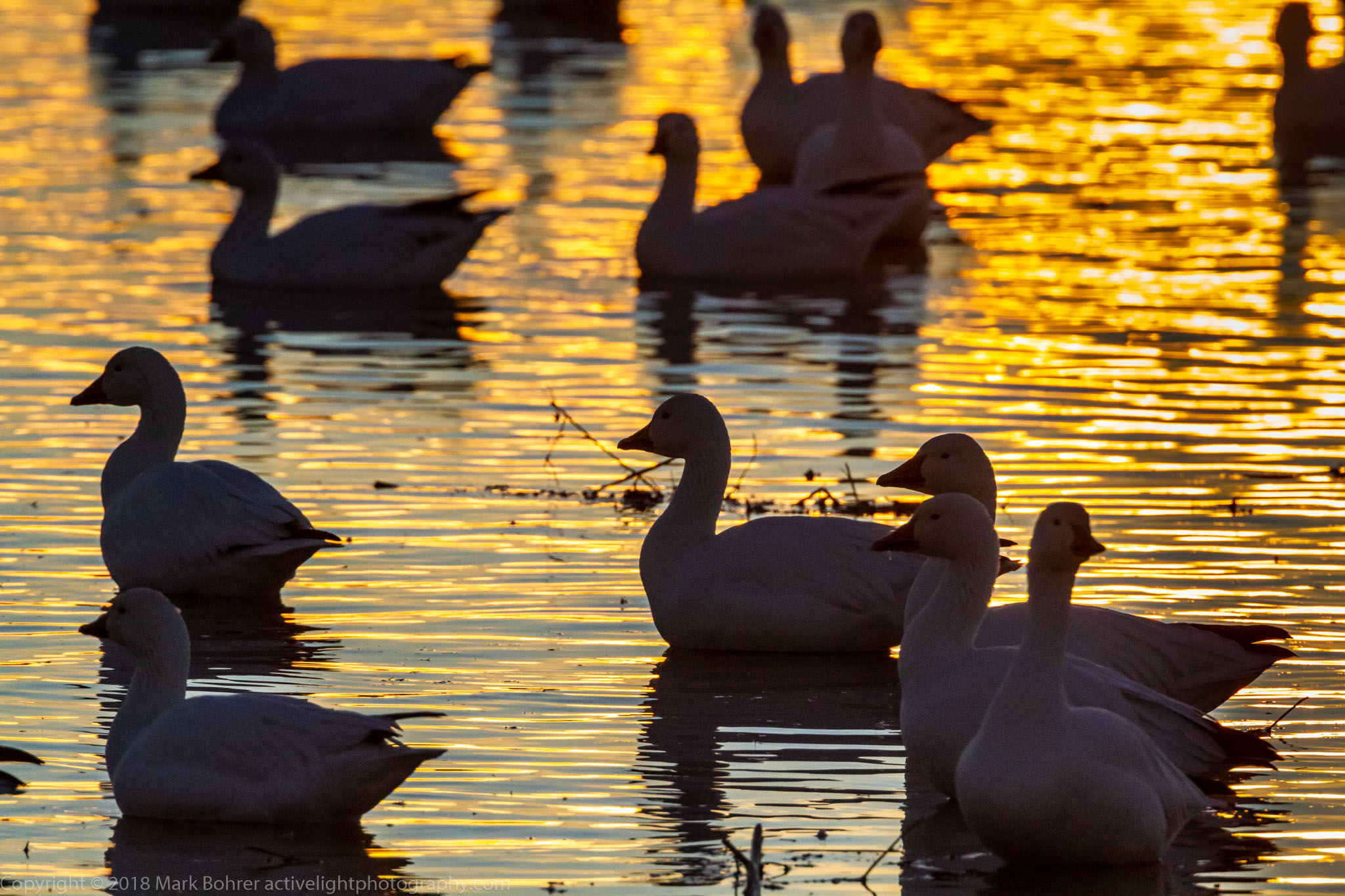 Golden goose silhouettes A young goose was splashing and bathing in front of his friends, who were doing their best to ignore him. He kept splashing away as I swung the 500mm over for a shot. As the sun started to peep over the mountains, a gold finger made its way through the pond and silhouetted more of the flock. Before full sunrise, I could actually capture some frontal feather detail from these backlit birds. After full sunrise, I had more subtle warm colors on those birds. Even with the extreme telephoto view I got small groups of the closest birds in each picture. But I could isolate the action of a few geese much better than my shorter lenses let me. 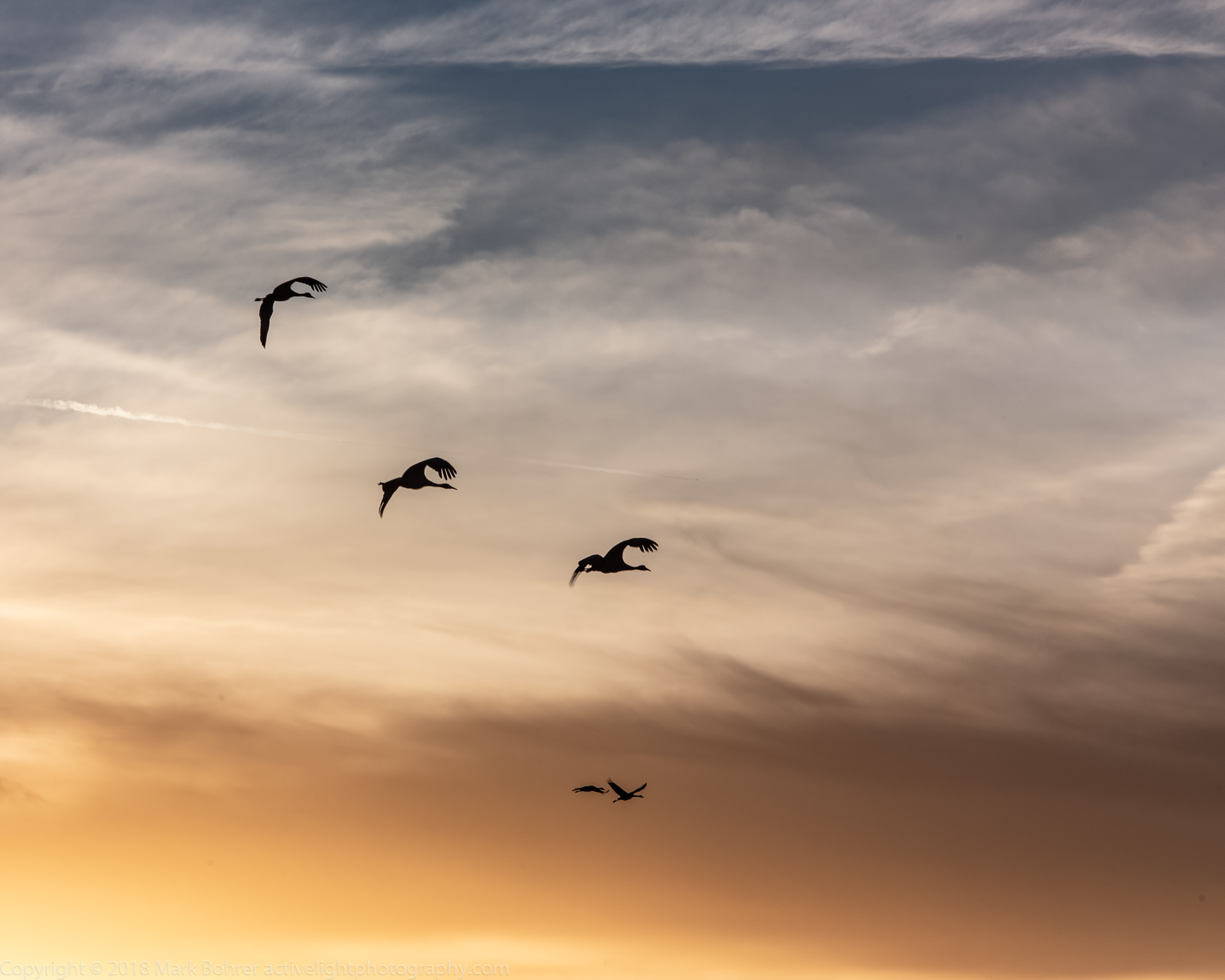 Crane flyover There were occasional crane and goose flyovers against a delicately patterned sky. I always prefer cloud patterns to boring plain blue. The clouds give your viewer something to place the birds on when they’re way higher than trees or mountains. Those background mountains also worked well for cranes doing low fly-bys. 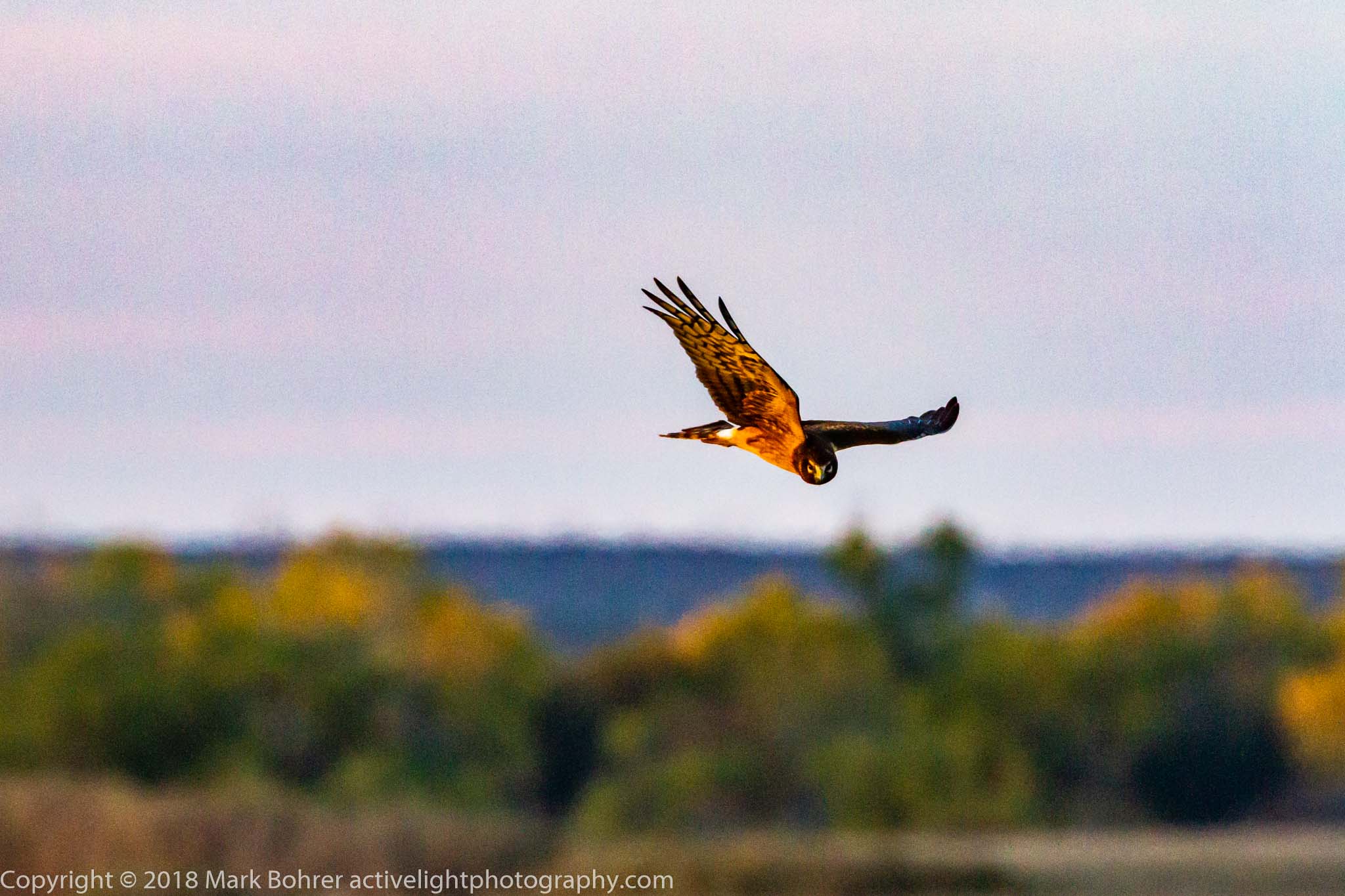 Northern Harrier – yes, the color really was like this A predatory northern harrier made a surprise appearance low over the shoreline. These guys use their strong sense of hearing to capture unsuspecting rats, mice and other small rodents. His owl-like face was well-lit by warm sunlight, giving me an ideal picture. Harriers’ faces perform the same task as they do for owls – they help focus the sounds of prey. his presence didn’t seem to overly concern the nearby geese. 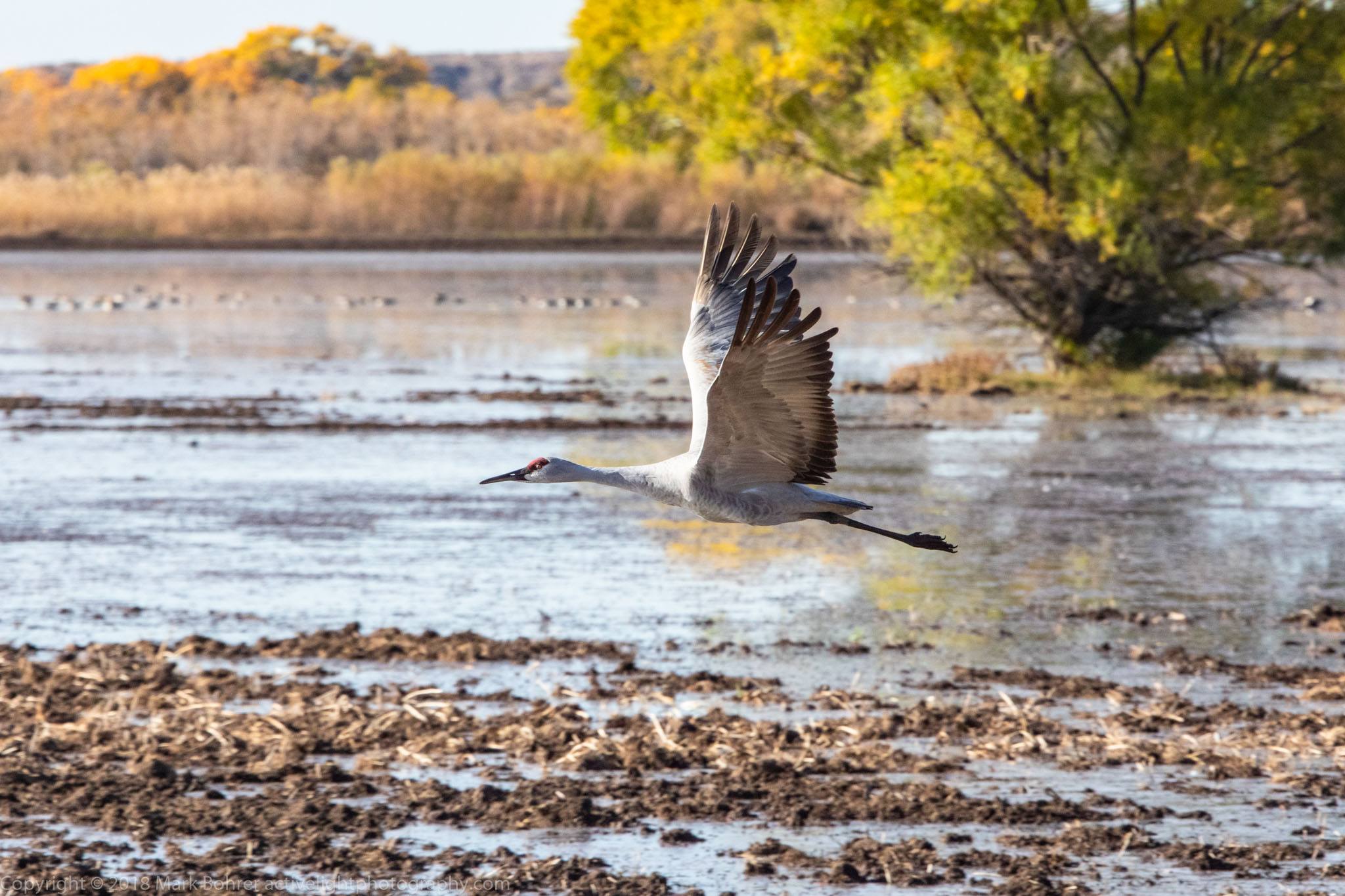 Solo crane flight over the marsh We tried another location just north and around a curve. There were some different views from the Farm Deck over the marsh, including closeups of a solitary crane flying low with a bald eagle perched on his tree in the background. Finally, it was time to go. As my old mentor Moose Peterson told me one morning in the Eastern Sierras, “Light’s getting pretty harsh – time for breakfast.” 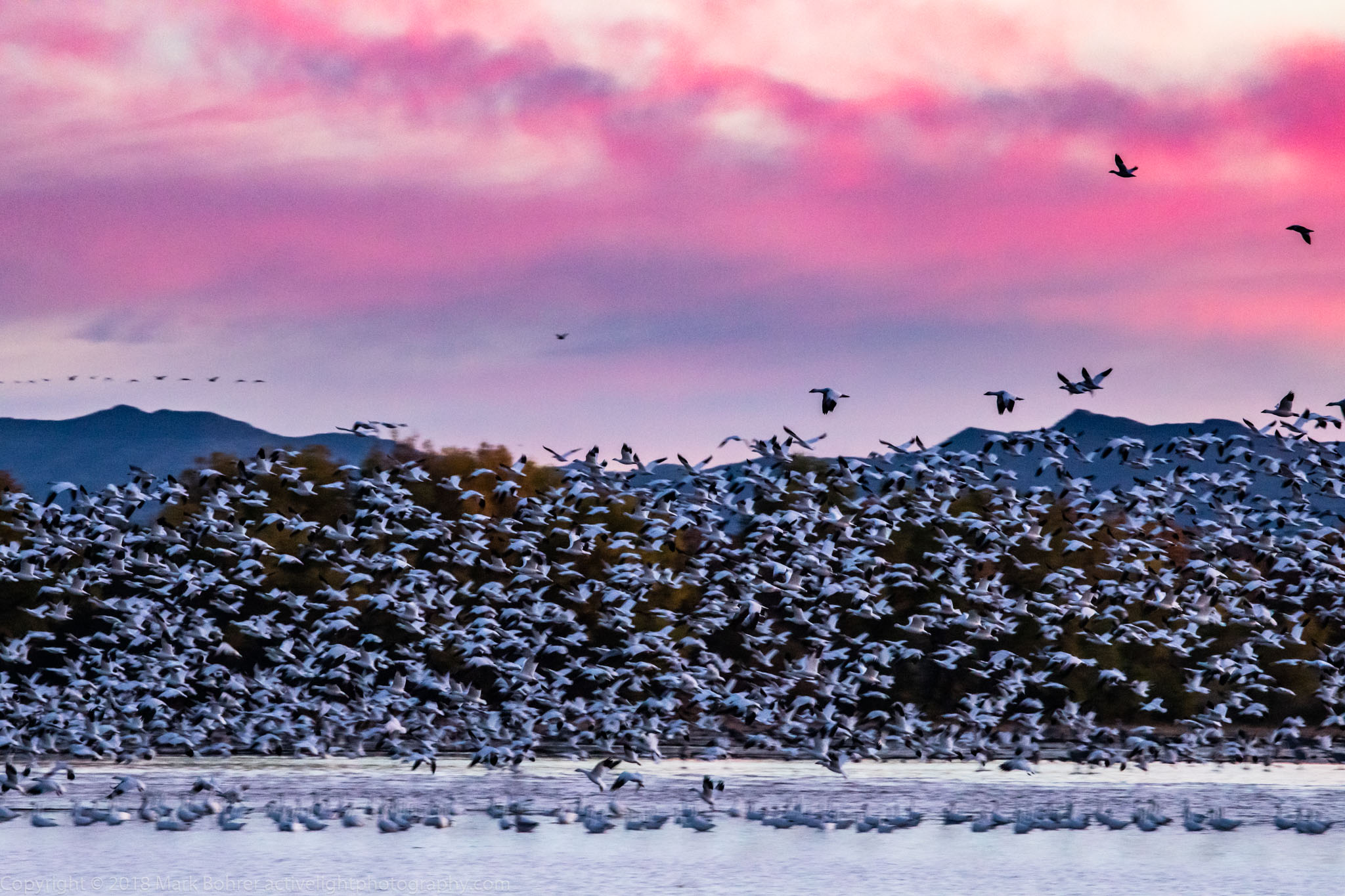 Pink sky liftoff Shot Notes A few times I found myself with three cameras strapped around my body. I usually don’t have more than two to keep equipment from crashing together, and (more importantly) keep neck straps from strangling me. But you can find yourself needing a wide landscape view, a short telephoto view, and a super long lens view. It wasn’t really intentional – I just kept wanting different lens views, and and grabbing more cameras. A few years ago when I was photographing egret and night heron nestlings at Palo Alto Baylands (California), a young bird fell out of its nest, to be rescued by a ranger. I had a second camera around my neck with a 16-35mm wide zoom, so I was able to capture the closeup I couldn’t have gotten with the 500mm. Quick access to multiple lenses gives you more chances to get the shot. At Bosque, lens needs were driven by swiftly-changing sunrise colors and flying birds creating dynamic landscapes. I did far fewer traditional bird portraits and flight shots, with more ‘birdscapes’ instead. I was unable to get close enough even with an 1120mm equivalent lens to isolate individual birds, so I made a virtue out of it with tight group compositions. And boy did it work. Yes, you can keep one lens on one camera and come back with keepers, but you’ll need to be happy with one distance range and one broad type of picture shooting wildlife. If your equipment closet has the gear, bring it. With wildlife, you’ll use all of it. More Information – Campendium (nd) Chupadero Mountain View RV Park. Retrieved from https://www.campendium.com/chupadero-mountain-view-rv-park This RV park is a great place to stay – clean, quiet, and just a few miles from Bosque del Apache. – Stephen Fischer Photography (nd) Bosque del Apache National Wildlife Refuge tour loop map. Retrieved from https://tinyurl.com/y9ztkyvf Wikipedia (nd) Snow Goose. Retrieved from https://en.wikipedia.org/wiki/Snow_goose Wikipedia (nd) Sandhill Crane. Retrieved from https://en.wikipedia.org/wiki/Sandhill_crane Wikipedia (nd) Northern Harrier. Retrieved from https://en.wikipedia.org/wiki/Sandhill_crane |
(408) 483-3782
Curious about how to shoot ruins?(408) 483-3782

Recent Comments